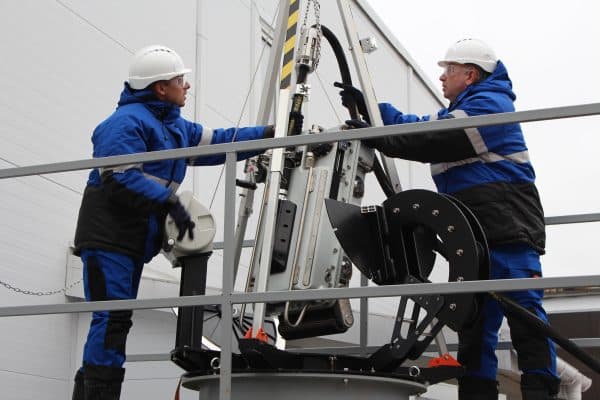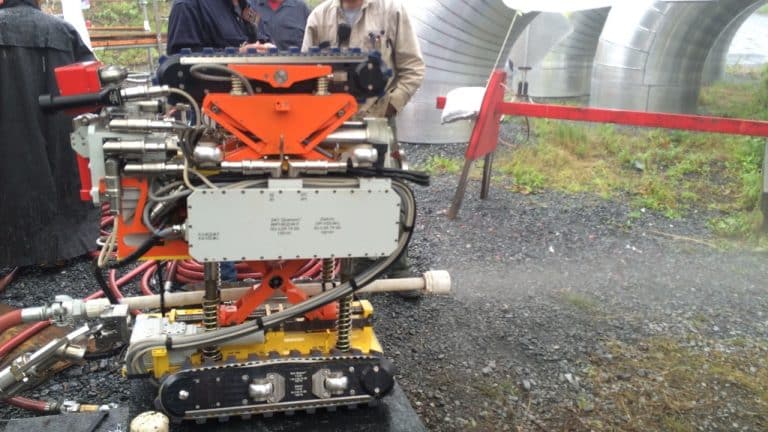Scheduling a storage tank outage to comply with regulations and industry standards can be inconvenient, especially when trying to align inspection schedules with repair schedules and customer expectations. Diakont has developed an inspection system to provide comprehensive storage tank floor inspection services while the tanks remain filled and operational to simplify tank inspection and maintenance. Certified Diakont inspection personnel use non-destructive testing (NDT) sensors and high-definition cameras on the crawler to deliver complete API 653-compliant inspection coverage.
Challenge
- Inspect four Chevron water tanks and a kerosene tank to deliver a complete API 653 compliant inspection coverage, while keeping tanks filled and operational.
Solution
- Utilize Diakont’s Stingray inspection system to minimize human risk during mandatory inspections and site operations while maximizing tank availability.
Results
- Diakont successfully demonstrated the Stingray tool launch, operation, and retrieval in all four tank inspections. The inspections navigated around the complex system of fire suppression piping and supported a site initiative to minimize human entry into confined spaces as well as being API 653 compliant.
Tank Entry Costs (Financial and Human)
Traditional storage tank inspections require inspectors to enter and occupy the tank for the duration of the inspection. Because this requires tank operators to drain, clean, and ventilate the tank, traditional inspection incurs both the actual cost of all operations and the opportunity cost of the tank being unavailable for use. Any personnel who enter the tank during the outage encounter confined space and hazardous substance hazards. The US Bureau of Labor Statistics reports 166 confined space fatalities in 2017 (an increase of 15% over 2016) as well as 531 fatalities due to harmful substance or environment exposure. Additionally, hazard communication, respiratory protection, and LOTO were three of the top five most frequently cited OSHA standards violated in 2018. The ability to inspect tanks without draining them will save storage tank operators substantial money, improve site safety, and maximize operational efficiency.
Robotic Inspection Service
The Stingray crawler is designed to inspect storage tanks up to 190 feet in diameter and 80 feet tall. Technicians deploy and retrieve the crawler via a device that bolts securely to a manhole on the tank roof; during the inspection, this device covers the manhole, preventing hazardous vapors from escaping the tank. The system is also explosion-proof certified for use in hazardous environments. The crawler combines magnetic flux leakage (MFL) and ultrasonic testing (UT) modules to ensure tool coverage complies with API 653 requirements. Unlike traditional inspections, which promise a full MFL scan but only use a secondary technology to confirm questionable findings, technicians use both NDT modules to gather data for the entire tank floor. In addition to ensuring all anomalies are located and measured, this additional data allows Diakont data analysts to provide accurate metal thickness readings for use in structural integrity efforts. Cameras on the crawler provide a view of the tank interior where conditions inside the tank permit. The crawler is also equipped with 3D sonar units to help technicians navigate in limited visibility as well as locate plate lap welds, the tank shell, and objects in the tank (e.g., roof drains, floating roof legs, the sump).
Service Value
- The Stingray completely eliminates lost revenue and increased costs inherent to service outages:
- Tank operators can schedule a Stingray inspection at their convenience rather than change their turnaround schedule to include a traditional inspection.
- Deploying the Stingray into a full tank to determine floor integrity helps optimize maintenance budgets by ensuring tanks are emptied for service only when necessary.
- Technicians climb onto the tank roof only to launch and retrieve the crawler, and never enter the tank. The Stingray’s remote operation eliminates the need to clean the tank or ensure tank interior safety for human entry, reducing inspection costs by up to 90%.
- Gaining inspection data prior to a planned outage rather than during the outage helps operators optimize project efficiency and further reduce turnaround time. The 600-foot long umbilical cable helps Diakont place the control station per operator preference to maximize inspection personnel safety and minimize inspection impact on other site operations.
Case Studies
Diakont successfully demonstrated Stingray tool launch, operation, and retrieval in three water tanks in 2017. Two of these water tanks were coordinated with Chevron and executed on Chevron property to confirm tool operation in a live work location. Diakont has subsequently used the system to inspect another water tank and a kerosene tank. The kerosene tank was coordinated with Chevron and executed on Chevron property to confirm safe operating procedures in hazardous environments (e.g., containment procedures during tool retrieval). As of 19 February 2019, Diakont has deployed Stingray equipment at a Chevron location for use in a diesel fuel tank. This inspection seeks to implement lessons learned during work at the kerosene tank as well as confirm work procedures in cold weather environments. Diakont also used the Stingray system in 2018 to inspect the steel floor of the secondary containment dike floor surrounding a benzene tank. This inspection demonstrated tool navigation capabilities around a complex system of fire suppression piping and supported a site initiative to minimize human entry into confined spaces.
Tank Operation Solution
Whether the tank floor requires a complete inspection or a condition assessment to support risk-based outage scheduling, Diakont’s Stingray inspection system minimizes human risk during mandatory inspections and site operations while maximizing tank availability.
Read More Tank Storage Magazine
References
1 National Census of Fatal Occupational Injuries in 2017. https://www.bls.gov/news.release/cfoi. nr0.htm. Accessed 19 February 2019.
2 Commonly Used Statistics. https://www.osha. gov/oshstats/commonstats.html. Accessed 19 February 2019.
Author:
This article was written by Tyler Powell, development program manager, Diakont Advanced Technologies. TPowell@diakont.us.com, www.diakont.com



